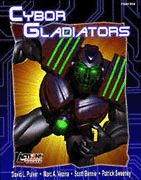
|
About OgreCave and its staff
|

|
by Matthew Pook
After allowing us to stomp Tokyo with giant rampaging monsters or "kaiju" of our own design with the Monster Island game and its supplements, the latest release from Firefly Games lets you take the fight to the stars and into the arena. Not with kaiju, but with slaves abducted by an alien empire, enhanced with cybernetic implants and set to fight to the death as gladiators for nothing more than the entertainment of their decadent masters. The Dzerini are an immortal race grown bored at vicarious pleasures, who have discovered that the only way that they can feel alive again is through experiencing the death of slaves in vicious blood sports. They have found four bipedal races suitable for the arenas and enslaved them through either kidnapping or purchase (one species even sees the Dzerini as gods!). The victims awake in the slavelabs where they are fitted with the alien biotechnology and military grade cyberware of the Dzerini. This always includes a pleasure/pain-inducing device inserted into their brain. A gladiator's trainer uses this device to enforce new combat skills and correct behavior, as well as to reward success in the arena. The basic idea in CyborGladiators is that each player designs their own combatant and they duel it out in the arena, either in one-on-one or free-for all fights. Alternatively, they can take on the role of Dzerini stable masters and control the destiny of their own house of gladiators. This allows different types of fight to be staged, such as Team-on-Team and Tag Team events. Gladiators are ranked into four classes: Lightweight, Middleweight, Heavyweight and Ultra-heavyweight. They start out in the Lightweight class and work their way up through the others as they win more fights, and thus money, which can be used to buy more upgrades. Eventually a gladiator might become famous enough to win their freedom. CyborGladiators uses the same Action! System mechanics employed in Monster Island, so players will need little more than a handful of six-sided dice. Arenas can be created on the table and a ruler used to measure out distances for movement and ranged combat, or better still on a battle mat marked out in one-inch hexes or squares. Alternatively, several companies produce games that come with ready to play maps in full color. This includes the Frag! board game and its supplements, the Floor Plan sets published by Steve Jackson Games, and both the Marvel and DC HeroClix CMGs from WizKids. Even the many maps available for BattleTech could be used as arenas for CyborGladiators.
Gearing up Several Dzerini guilds manufacture the range of implants available. They include limbs, internal organs, neural implants and various miscellaneous items. A cybered-up gladiator can be fitted with subtle bionic arms or obviously metal exo-arms or legs, battle computers or beserker chips, a replacement robo-head if they lose their original (it does turn them into a robot!), a bionic tail or cyber-jaws, telescopic limbs for extra reach, cyber-arm sockets for plug in and maim weapons, cyberhair, or laser eye implants for that look-and-zap attack. How much a player has to spend on their cyberware depends upon their class, each of which sets a budget. Unless the cyberware is obvious, such as an exo-arm, it can remain hidden until used in the arena. A gladiator needs to buy and equip weapons, which tend to be suited for melee combat, as the Dzerini find this better satiates their need for blood. Ranged weapons are available, but any laser or ion gun will always be set to a semi-automatic fire rate only. The Dzerini hate to see a combatant taken down too quickly with a burst of blaster fire.
Applying the beat-down Arenas can be designed, perhaps one for each of the stables participating in a game, so that they can have a home arena. Failing that, a set of tables helps to create one randomly. At the end of a fight, experience can come in the form of victory purses, which can be used to buy upgrades or pay for repairs. Depending upon their conduct in the arena, a gladiator can gain Glory Points, usually only one or two per bout. They measure the growth of a gladiator's fame, their status growing with every six Glory Points awarded. Glory Point awards from a fight can never amount to less than zero, which is a shame, as gladiators should be able to lose status as well as gaining it. Whenever they go up in status, gladiators are also rewarded with a one-point rise to one of their four core attributes. If a gladiator achieves Legendary Champion status then they can retire, details of which are given in a table. Some of the six results listed, such as becoming a pirate to strike back at the Dzerini, have potential as campaigns in their own right. CyborGladiators is rounded out with write-ups of several gladiators, and these include an ex-rodeo clown! These match up with the small set of full color stand-ups that together can result in a quick start up time to a game, should the players not want to design their own. Record sheets are also provided for characters, arenas and tournament match-ups so that a knockout-style championship can be run. As a book, CyborGladiators is well laid out and entertainingly written. In particular, the fiction that begins each chapter is most enjoyable. This relates the story of an American Special Forces soldier who is abducted and turned into a gladiator. Over the course of the book we learn of his experiences and as he achieves great fame, also of his plans for life beyond the arena. The listings of the various items of cyberware and biotechnology are nicely arranged as if they are part of an electronic catalogue from which a stable master can freely select at the touch of the screen.
Conclusions
|
||
 CyborGladiators
CyborGladiators